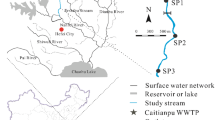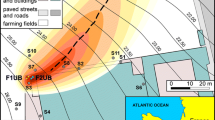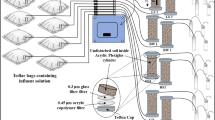Abstract
This research investigates the biodegradation of perchlorate in the presence of the co-contaminants nitrate and chlorate using soluble and slow-release carbon sources. In addition, the impact of bio-augmentation and dilution, which results in lower total dissolved salts (TDS) and contaminant levels, is examined. Laboratory microcosms were conducted using actual groundwater and soils from a contaminated aquifer. The results revealed that both soluble and slow-release carbon sources support biodegradation of contaminants in the sequence nitrate > chlorate > perchlorate. Degradation rates, including and excluding lag times, revealed that the overall impact of the presence of co-contaminants depends on degradation kinetics and the relative concentrations of the contaminants. When the lag time caused by the presence of the co-contaminants is considered, the degradation rates for chlorate and perchlorate were two to three times slower. The results also show that dilution causes lower initial contaminant concentrations, and consequently, slower degradation rates, which is not desirable. On the other hand, the dilution resulting from the injection of amendments to support remediation promotes desirably lower salinity levels. However, the salinity associated with the presence of sulfate does not inhibit biodegradation. The naturally occurring bacteria were able to support the degradation of all contaminants. Bio-augmentation was effective only in diluted microcosms. Proteobacteria and Firmicutes were the dominant phyla identified in the microcosms.
Graphical abstract







Similar content being viewed by others
References
Abdul-Talib S, Hvitved-Jacobsen T, Vollertsen J, Ujang Z (2002) Half saturation constants for nitrate and nitrite by in-sewer anoxic transformations of wastewater organic matter. Water Sci Technol 46(9):185–192. https://doi.org/10.2166/wst.2002.0236
Altendorf K, Wood JM, Rosenthal AZ, Gralla J, Greie J-C, Booth IR (2009) Osmotic stress. EcoSal Plus. https://doi.org/10.1128/ecosalplus.5.4.5
Bardiya N, Bae JH (2011) Dissimilatory perchlorate reduction: a review. Microbiol Res 166(4):237–254. https://doi.org/10.1016/j.micres.2010.11.005
Batista JR, Papelis L, Kesterson K, Amy P (2005) Potential for bioremediation of the perchlorate-contaminated sediments in the Las Vegas Wash area, Henderson, Nevada. Remediation 15(4):73–87. https://doi.org/10.1002/rem.20061
Borden RC (2007) Effective distribution of emulsified edible oil for enhanced anaerobic bioremediation. J Contam Hydrol 94(1–2):1–12. https://doi.org/10.1016/j.jconhyd.2007.06.001
Bruker (2020) X-ray structural and elemental analysis. https://www.bruker.com/products/x-ray-diffraction-and-elemental-analysis.html. Accessed 4 July 2022
Cao F, Jaunat J, Sturchio N, Cancès B, Morvan X, Devos A, Barbin V, Ollivier P (2019) Worldwide occurrence and origin of perchlorate ion in waters: a review. Sci Total Environ 661:737–749. https://doi.org/10.1016/j.scitotenv.2019.01.107
Caporaso JG, Kuczynski J, Stombaugh J, Bittinger K, Bushman FD, Costello EK, Fierer N, Peña AG, Goodrich JK, Gordon JI, Huttley GA, Kelley ST, Knights D, Koenig JE, Ley RE, Lozupone CA, McDonald D, Muegge BD, Pirrung M, Reeder J, Sevinsky JR, Turnbaugh PJ, Walters WA, Widmann J, Yatsunenko T, Zaneveld J, Knight R (2010) QIIME allows analysis of high-throughput community sequencing data. Nat Methods 7(5):335–336. https://doi.org/10.1038/nmeth.f.303
Carlström CI, Loutey DE, Wang O, Engelbrektson A, Clark I, Lucas LN, Somasekhar PY, Coates JD (2015) Phenotypic and genotypic description of Sedimenticola selenatireducens strain CUZ, a marine (per)chlorate-respiring gammaproteobacterium, and its close relative the chlorate-respiring Sedimenticola strain NSS. Appl Environ Microbiol 81(8):2717–2726. https://doi.org/10.1128/AEM.03606-14
Carlström CI, Lucas LN, Rohde RA, Haratian A, Engelbrektson AL, Coates JD (2016) Characterization of an anaerobic marine microbial community exposed to combined fluxes of perchlorate and salinity. Appl Microbiol Biotechnol 100(22):9719–9732. https://doi.org/10.1007/s00253-016-7780-5
Chaudhuri SK, O’Connor SM, Gustavson RL, Achenbach LA, Coates JD (2002) Environmental factors that control microbial perchlorate reduction. Appl Environ Microbiol 68(9):4425–4430. https://doi.org/10.1128/AEM.68.9.4425-4430.2002
Choi H, Silverstein JA (2008) Inhibition of perchlorate reduction by nitrate in a fixed biofilm reactor. J Hazard Mater 159(2–3):440–445. https://doi.org/10.1016/j.jhazmat.2008.02.038
Chung J, Nerenberg R, Rittmann BE (2007) Evaluation for biological reduction of nitrate and perchlorate in brine water using the hydrogen-based membrane biofilm reactor. J Environ Eng 133(2):157–164. https://doi.org/10.1061/(ASCE)0733-9372(2007)133:2(157)
Coates JD, Achenbach LA (2004) Microbial perchlorate reduction: rocket-fuelled metabolism. Nat Rev Microbiol 2(7):569–580. https://doi.org/10.1038/nrmicro926
Coulibaly KM, Borden RC (2004) Impact of edible oil injection on the permeability of aquifer sands. J Contam Hydrol 71(1–4):219–237. https://doi.org/10.1016/j.jconhyd.2003.10.002
Coulibaly KM, Long CM, Borden RC (2006) Transport of edible oil emulsions in clayey sands: one-dimensional column results and model development. ASCE J 11(June):230–237. https://doi.org/10.1061/(ASCE)1084-0699(2006)11
Ebrahimi S, Nguyen TH, Roberts DJ (2015) Effect of temperature & salt concentration on salt tolerant nitrate-perchlorate reducing bacteria: nitrate degradation kinetics. Water Res 83:345–353. https://doi.org/10.1016/j.watres.2015.07.006
Freundlich H (1907) Über die adsorption in Lösungen. Z Phys Chem 57U(1):385–470. https://doi.org/10.1515/zpch-1907-5723
Gal H, Ronen Z, Weisbrod N, Dahan O, Nativ R (2008) Perchlorate biodegradation in contaminated soils and the deep unsaturated zone. Soil Biol Biochem 40(7):1751–1757. https://doi.org/10.1016/j.soilbio.2008.02.015
Ghosh A, Pakshirajan K, Ghosh PK, Sahoo NK (2011) Perchlorate degradation using an indigenous microbial consortium predominantly Burkholderia sp. J Hazard Mater 187(1–3):133–139. https://doi.org/10.1016/j.jhazmat.2010.12.130
Gingras TM, Batista JR (2002) Biological reduction of perchlorate in ion exchange regenerant solutions containing high salinity and ammonium levels. J Environ Monit 4(1):96–101. https://doi.org/10.1039/b107358n
Glass C, Silverstein J (1999) Denitrification of high-nitrate, high-salinity wastewater. Water Res 33(1):223–229. https://doi.org/10.1016/S0043-1354(98)00177-8
Guarino F et al (2020) Preferential use of the perchlorate over the nitrate in the respiratory processes mediated by the Bacterium Azospira sp. OGA 24. Water (Switzerland). https://doi.org/10.3390/w12082220
Hamlin HJ, Michaels JT, Beaulaton CM, Graham WF, Dutt W, Steinbach P, Losordo TM, Schrader KK, Main KL (2008) Comparing denitrification rates and carbon sources in commercial scale upflow denitrification biological filters in aquaculture. Aquacult Eng 38(2):79–92. https://doi.org/10.1016/j.aquaeng.2007.11.003
He H, Chen Y, Li X, Cheng Y, Yang C, Zeng G (2017) Influence of salinity on microorganisms in activated sludge processes: a review. Int Biodeterior Biodegrad 119:520–527. https://doi.org/10.1016/j.ibiod.2016.10.007
He B et al (2018) Migration, clogging, and carbon source release of nano emulsified vegetable oil in porous media, evaluated by column experiments. Bioremediat J 22(1–2):33–42. https://doi.org/10.1080/10889868.2018.1476451
He L, Zhong Y, Yao F, Chen F, Xie T, Wu B, Hou K, Wang D, Li X, Yang Q (2019) Biological perchlorate reduction: which electron donor we can choose? Environ Sci Pollut Res 26(17):16906–16922. https://doi.org/10.1007/s11356-019-05074-5
Hunter WJ (2002) Bioremediation of chlorate or perchlorate contaminated water using permeable barriers containing vegetable oil. Curr Microbiol 45(4):287–292. https://doi.org/10.1007/s00284-002-3751-4
Hunter WJ (2005) Injection of innocuous oils to create reactive barriers for bioremediation: laboratory studies. J Contam Hydrol 80(1–2):31–48. https://doi.org/10.1016/j.jconhyd.2005.06.008
Ji B, Yang K, Zhu L, Jiang Y, Wang H, Zhou J, Zhang H (2015) Aerobic denitrification: a review of important advances of the last 30 years. Biotechnol Bioprocess Eng 20(4):643–651. https://doi.org/10.1007/s12257-015-0009-0
Kotlarz N, Upadhyaya G, Togna P, Raskin L (2016) Evaluation of electron donors for biological perchlorate removal highlights the importance of diverse perchlorate-reducing populations. Environ Sci Water Res Technol 2(6):1049–1063. https://doi.org/10.1039/c6ew00181e
Kumarathilaka P, Oze C, Indraratne SP, Vithanage M (2016) Perchlorate as an emerging contaminant in soil, water and food. Chemosphere 150:667–677. https://doi.org/10.1016/j.chemosphere.2016.01.109
Kushkevych I, Dordević D, Vítězová M (2019) Toxicity of hydrogen sulfide toward sulfate-reducing bacteria Desulfovibrio piger Vib-7. Arch Microbiol 201(3):389–397. https://doi.org/10.1007/s00203-019-01625-z
Langmuir I (1918) The adsorption of gases on plane surfaces of glass, mica and platinum. J Am Chem Soc 40(9):1361–1403. https://doi.org/10.1021/ja02242a004
Lehman SG, Badruzzaman M, Adham S, Roberts DJ, Clifford DA (2008) Perchlorate and nitrate treatment by ion exchange integrated with biological brine treatment. Water Res 42(4–5):969–976. https://doi.org/10.1016/j.watres.2007.09.011
León-Zayas R, Peoples L, Biddle JF, Podell S, Novotny M, Cameron J, Lasken RS, Bartlett DH (2017) The metabolic potential of the single cell genomes obtained from the Challenger Deep, Mariana Trench within the candidate superphylum Parcubacteria (OD1). Environ Microbiol 19(7):2769–2784. https://doi.org/10.1111/1462-2920.13789
Leung AM, Pearce EN, Braverman LE (2010) Perchlorate, iodine and the thyroid. Best Pract Res Clin Endocrinol Metab 24(1):133–141. https://doi.org/10.1016/j.beem.2009.08.009
Levakov I, Ronen Z, Dahan O (2019) Combined in-situ bioremediation treatment for perchlorate pollution in the vadose zone and groundwater. J Hazard Mater 369(February):439–447. https://doi.org/10.1016/j.jhazmat.2019.02.014
Li ZY, Li X, Tan B et al (2020) NC10 bacteria promoted methane oxidation coupled to chlorate reduction. Biodegradation 31:319–329. https://doi.org/10.1007/s10532-020-09912-z
Liebensteiner MG, Oosterkamp MJ, Stams AJM (2016) Microbial respiration with chlorine oxyanions: diversity and physiological and biochemical properties of chlorate- and perchlorate-reducing microorganisms. Ann N Y Acad Sci 1365(1):59–72. https://doi.org/10.1111/nyas.12806
Logan BE et al (2001) Kinetics of perchlorate- and chlorate-respiring bacteria. Appl Environ Microbiol 67(6):2499–2506. https://doi.org/10.1128/AEM.67.6.2499-2506.2001
Mercado A, Libhaber M, Soares MIM (1988) In situ biological groundwater denitrification: concepts and preliminary field tests. Water Sci Technol 20(3):197–209. https://doi.org/10.2166/wst.1988.0099
Mohseni-Bandpi A, Elliott DJ, Zazouli MA (2013) Biological nitrate removal processes from drinking water supply—a review. J Environ Health Sci Eng 11(1):1–11. https://doi.org/10.1186/2052-336X-11-35
Nerenberg R, Kawagoshi Y, Rittmann BE (2006) Kinetics of a hydrogen-oxidizing, perchlorate-reducing bacterium. Water Res 40(17):3290–3296. https://doi.org/10.1016/j.watres.2006.06.035
Nozawa-Inoue M et al (2011) Effect of nitrate, acetate, and hydrogen on native perchlorate-reducing microbial communities and their activity in vadose soil. FEMS Microbiol Ecol 76(2):278–288. https://doi.org/10.1111/j.1574-6941.2011.01045.x
Okeke BC, Giblin T, Frankenberger WT (2002) Reduction of perchlorate and nitrate by salt tolerant bacteria. Environ Pollut 118(3):357–363. https://doi.org/10.1016/S0269-7491(01)00288-3
Reis MAM et al (1992) Effect of hydrogen sulfide on growth of sulfate reducing bacteria. Biotechnol Bioeng 40(5):593–600. https://doi.org/10.1002/bit.260400506
Ricardo AR, Carvalho G, Velizarov S, Crespo JG, Reis MAM (2012) Kinetics of nitrate and perchlorate removal and biofilm stratification in an ion exchange membrane bioreactor. Water Res 46(14):4556–4568. https://doi.org/10.1016/j.watres.2012.05.045
Robinson-Lora MA, Brennan RA (2009) The use of crab-shell chitin for biological denitrification: batch and column tests. Bioresour Technol 100(2):534–541. https://doi.org/10.1016/j.biortech.2008.06.052
Rodríguez-Fernández D, Torrentó C, Guivernau M, Viñas M, Hunkeler D, Soler A, Domènech C, Rosell M (2018) Vitamin B12 effects on chlorinated methanes-degrading microcosms: dual isotope and metabolically active microbial populations assessment. Sci Total Environ 621:1615–1625. https://doi.org/10.1016/j.scitotenv.2017.10.067
Sarria M, Gonzales JM, Gerrity D, Batista J (2019) Biological reduction of nitrate and perchlorate in soil microcosms: an electron donor comparison of glycerol, emulsified oil, and mulch extract. Groundw Monit Remediat 39(2):32–42. https://doi.org/10.1111/gwmr.12315
Schaefer CE, Fuller ME, Condee CW, Lowey JM, Hatzinger PB (2007) Comparison of biotic and abiotic treatment approaches for co-mingled perchlorate, nitrate, and nitramine explosives in groundwater. J Contam Hydrol 89(3–4):231–250. https://doi.org/10.1016/j.jconhyd.2006.09.002
Schwarz AO, Urrutia H, Vidal JM, Pérez N (2012) Chlorate reduction capacity and characterisation of chlorate reducing bacteria communities in sediments of the rio Cruces wetland in southern Chile. Water Res 46(10):3283–3292. https://doi.org/10.1016/j.watres.2012.03.046
Sharbatmaleki M, Unz RF, Batista JR (2015) Potential mechanisms for bioregeneration of perchlorate-containing ion-exchange resin. Water Res 75:1–10. https://doi.org/10.1016/j.watres.2015.02.027
Shaw A, Takács I, Pagilla KR, Murthy S (2013) A new approach to assess the dependency of extant half-saturation coefficients on maximum process rates and estimate intrinsic coefficients. Water Res 47(16):5986–5994. https://doi.org/10.1016/j.watres.2013.07.003
Shrout JD, Scheetz TE, Casavant TL, Parkin GF (2005) Isolation and characterization of autotrophic, hydrogen-utilizing, perchlorate-reducing bacteria. Appl Microbiol Biotechnol 67(2):261–268. https://doi.org/10.1007/s00253-004-1725-0
Son A, Lee J, Chiu PC, Kim BJ, Cha DK (2006) Microbial reduction of perchlorate with zero-valent iron. Water Res 40(10):2027–2032. https://doi.org/10.1016/j.watres.2006.03.027
Tan K, Anderson TA, Jackson WA (2004) Degradation kinetics of perchlorate in sediments and soils. Water Air Soil Pollut 151(1–4):245–259. https://doi.org/10.1023/B:WATE.0000009904.23410.89
Ucar D, Sahinkaya E, Yilmaz T, Cakmak Y (2019) Simultaneous nitrate and perchlorate reduction in an elemental sulfur-based denitrifying membrane bioreactor. Int Biodeterior Biodegrad 144(1):104741. https://doi.org/10.1016/j.ibiod.2019.104741
US-EPA (1996) US-EPA 6010B method revision (2) inductively coupled plasma-atomic emission spectrometry. https://archive.epa.gov/epawaste/hazard/testmethods/web/html/6_series.html. Accessed 4 July 2022
van der Hoek JP, Latour PJM, Klapwijk A (1987) Denitrification with methanol in the presence of high salt concentrations and at high pH levels. Appl Microbiol Biotechnol 27(2):199–205. https://doi.org/10.1007/BF00251945
Van Ginkel SW, Ahn CH, Badruzzaman M, Roberts DJ, Lehman SG, Adham SS, Rittmann BE (2008) Kinetics of nitrate and perchlorate reduction in ion-exchange brine using the membrane biofilm reactor (MBfR). Water Res 42(15):4197–4205. https://doi.org/10.1016/j.watres.2008.07.012
Venkatesan AK, Batista JR (2011) Investigation of factors affecting the bioregeneration process for perchlorate-laden gel-type anion-exchange resin. Bioremediat J 15(1):1–11. https://doi.org/10.1080/10889868.2010.547997
Vijaya Nadaraja A, Gangadharan Puthiya Veetil P, Bhaskaran K (2013) Perchlorate reduction by an isolated Serratia marcescens strain under high salt and extreme pH. FEMS Microbiol Lett 339(2):117–121. https://doi.org/10.1111/1574-6968.12062
Waller AS, Cox EE, Edwards EA (2004) Perchlorate-reducing microorganisms isolated from contaminated sites. Environ Microbiol 6(5):517–527. https://doi.org/10.1111/j.1462-2920.2004.00598.x
Wang Q, Garrity GM, Tiedje JM, Cole JR (2007) Naïve Bayesian classifier for rapid assignment of rRNA sequences into the new bacterial taxonomy. Appl Environ Microbiol 73(16):5261–5267. https://doi.org/10.1128/AEM.00062-07
Wang Y, Jin L, Deshusses MA, Matsumoto MR (2013) The effects of various amendments on the biostimulation of perchlorate reduction in laboratory microcosm and flowthrough soil columns. Chem Eng J 232:388–396. https://doi.org/10.1016/j.cej.2013.07.060
Wang O et al (2018) Functional redundancy in perchlorate and nitrate electron transport chains and rewiring respiratory pathways to alter terminal electron acceptor preference. Front Microbiol 9(MAR):1–10. https://doi.org/10.3389/fmicb.2018.00376
Wen LL, Zhang Y, Chen JX, Zhang ZX, Yi YY, Tang Y, Rittmann BE, Zhao HP (2017) The dechlorination of TCE by a perchlorate reducing consortium. Chem Eng J 313:1215–1221. https://doi.org/10.1016/j.cej.2016.11.021
Wood JM (2015) Bacterial responses to osmotic challenges. J Gen Physiol 145(5):381–388. https://doi.org/10.1085/jgp.201411296
Xiao Y, Roberts DJ (2013) Kinetics analysis of a salt-tolerant perchlorate-reducing bacterium: effects of sodium, magnesium, and nitrate. Environ Sci Technol 47(15):8666–8673. https://doi.org/10.1021/es400835t
Xu X, Gao B, Jin B, Zhen H, Wang X, Dai M (2015) Study of microbial perchlorate reduction: considering of multiple pH, electron acceptors and donors. J Hazard Mater 285:228–235. https://doi.org/10.1016/j.jhazmat.2014.10.061
Youngblut MD, Wang O, Barnum TP, Coates JD (2016) (Per)chlorate in biology on earth and beyond. Annu Rev Microbiol 70:435–457. https://doi.org/10.1146/annurev-micro-102215-095406
Zhang Y, Chen JX, Wen LL, Tang Y, Zhao HP (2016) Effects of salinity on simultaneous reduction of perchlorate and nitrate in a methane-based membrane biofilm reactor. Environ Sci Pollut Res 23(23):24248–24255. https://doi.org/10.1007/s11356-016-7678-x
Zhao HP, Van Ginkel S, Tang Y, Kang DW, Rittmann B, Krajmalnik-Brown R (2011) Interactions between perchlorate and nitrate reductions in the biofilm of a hydrogen-based membrane biofilm reactor. Environ Sci Technol 45(23):10155–10162. https://doi.org/10.1021/es202569b
Zhao W, Wang Y, Liu S, Pan M, Yang J, Chen S (2013) Denitrification activities and N2O production under salt stress with varying COD/N ratios and terminal electron acceptors. Chem Eng J 215–216(3):252–260. https://doi.org/10.1016/j.cej.2012.10.084
Zuo G (2008) Kinetics and microbial ecology of two salt-tolerant perchlorate-reducing enrichment cultures. Dissertation, University of Houston
Acknowledgements
This study was supported by a grant from the Nevada Environmental Response Trust (NERT) in collaboration with Tetra Tech Inc. The authors would like to thank the Department of Earth, Ocean, and Atmospheric Sciences at University of British Columbia, Canada, for conducting the X-ray diffraction testing. The authors also would like to thank Nicole Martin for providing the characterization of the FBR sludge data and Meagan Madariaga-Hopkins, Technical Writer, for editing the manuscript.
Author information
Authors and Affiliations
Contributions
YS carried out the soil and groundwater chemical characterization, conducted microcosm batch experiments and oil sorption studies, curated data, and evaluated microbial data, and drafted of the manuscript. JB conceptualized the idea, wrote research grant funding, supervised the research project as the principle investigator, reviewed and edited manuscript. RB and DG supervised field drilling operations to obtain soil and groundwater samples from the contaminate site, supervised research progress, and reviewed and commented on the manuscript.
Corresponding author
Ethics declarations
Competing interests
The authors declare that they have no known competing financial interests or personal relationships that could have appeared to influence the work reported in this paper.
Additional information
Publisher's Note
Springer Nature remains neutral with regard to jurisdictional claims in published maps and institutional affiliations.
Supplementary Information
Below is the link to the electronic supplementary material.
Rights and permissions
Springer Nature or its licensor (e.g. a society or other partner) holds exclusive rights to this article under a publishing agreement with the author(s) or other rightsholder(s); author self-archiving of the accepted manuscript version of this article is solely governed by the terms of such publishing agreement and applicable law.
About this article
Cite this article
Saedi, Y., Batista, J.R., Britto, R. et al. Impacts of co-contaminants and dilution on perchlorate biodegradation using various carbon sources. Biodegradation 34, 301–323 (2023). https://doi.org/10.1007/s10532-022-10013-2
Received:
Accepted:
Published:
Issue Date:
DOI: https://doi.org/10.1007/s10532-022-10013-2




